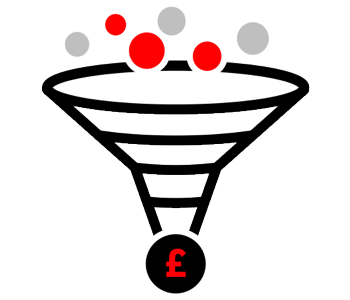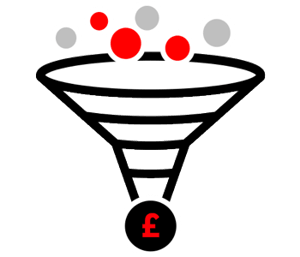The 5 characteristics of an effective sales process
April 28, 2016

There is abundant evidence to prove that companies with an effective sales process outperform their less disciplined competitors. The latest research from MHI shows a remarkable impact across a range of key performance metrics.
 Compared to their peer group, in organisations with an effective sales process:
Compared to their peer group, in organisations with an effective sales process:
- Average win rates are 31% higher
- 21% more sales people achieve quota
- Company-wide revenue performance is 17% higher
If asked, most organisations will tell you that they already have a sales process. But in my experience only a few have developed their sales processes to a level that consistently generates a compelling competitive advantage.
10 years of successful client engagements have led me to identify 5 common characteristics of truly effective sales processes. I hope that you’ll be reassured to learn that none involve rocket science…
1: DOCUMENTED
If they are to stand any chance of being adopted, sales processes must be clearly defined and documented. Simply labelling the stages in your sales pipeline does not count.
At minimum, your sales process needs to provide:
- A sequence of clearly defined stages separated by unambiguous buyer-behaviour related milestones that provide direct evidence of the true status of every sales opportunity
- Insights into what your prospect’s attention is likely to be focused on during each stage, which stakeholder types are likely to be involved, and what they will need from you before moving forwards
- Guidance as to what best practice suggests your sales people need to know, say and do at each stage of the process, combined with easy access to the necessary sales resources
- A series of progressive qualification criteria that enable each opportunity to be rationally and consistently re-assessed at each stage of the sales process
These guidelines need to be incorporated into your CRM solution so that it is as easy as possible for your sales people to be reminded of what they need to do at each stage to maximise their chances of winning.
2: ADOPTED
There’s no point in documenting and defining a sales process that your sales people are not motivated to adopt. It’s critical that they regard the expected actions, activities and behaviours as being directly relevant to enabling them to win more business, exceed their targets and maximise their commission payments.
This is where so many sales process initiatives fall down: they over-complicate the process to the point where your best sales people see it as a constraint that slows them down, rather than an aide that enables them to make smarter decisions at every point in the sales cycle.
That’s why it’s so important that your sales process - and they way you choose to implement it - doesn’t feel like yet another example of unnecessary administration. You must avoid over-complicating the process: the majority of the value always comes from a handful of elements at each stage.
Perhaps most important of all, the greatest value comes from stimulating your sales people to stop and think about the current stage of each opportunity, and to challenge themselves as to whether they have truly considered every aspect that could affect their ultimate success.
It’s often best to use simple stage-related checklists that draw each sales person’s attention to the critical things that experience suggests they need to know and do in order to successfully navigate each stage of the process.
And if any of your sales people claim that they have so much experience that they don’t need such guidance, I suggest you draw their attention to highly skilled professionals such as airline pilots or consultant surgeons, who would not dream of questioning the value of working within a defined process.
Last point on this topic: you must ensure that your defined process reflects the winning habits of your top sales performers. If you don’t, one of the most telling indicators of a poorly designed sales process is that your top performers ignore it, and still out-perform the rest, while your weaker sales people adopt it and yet fail to hit their revenue targets.
3: ADAPTABLE
In any complex sales environment, sales processes have to be both adaptable and dynamic. They must be more skeleton than cage: they must support core best practices whilst giving intelligent sales people the full freedom to react and adapt to the specific circumstances of individual opportunities.
This flexibility is critical: rigid, prescriptive and heavily scripted sales processes might work in some high volume transactional environments in which selling is fundamentally a numbers game, but they have a negative impact on performance in complex sales situations.
And even if your current sales process accurately reflects best practice in your current business environment, your sales people will inevitably encounter new opportunities, confront new obstacles and have to cope with an increasingly well-informed customer community.
Effective sales processes continuously adapt to reflect the latest learning - and need to be reviewed at regular intervals to ensure that they still reflect the best ways of finding, engaging, qualifying and closing more of the right sort of sales opportunities.
4: MEASURED
The obvious test of an effective sales process is how actions convert into profitable revenue. But it’s not just about the bookings: a well-managed sales process generates a stream of useful metrics. Some of the most useful include:
- Win Rate (both overall, and sliced-and-diced by product, campaign, region, sales person, and so on)
- Conversion Rate (what percentage of opportunities convert from one stage to the next and from the start to the end of the sales process)
- Deal Velocity (how long it takes opportunities to move from stage to stage and from start to the end of the sales process)
- Push Rate (how often the close date associated with opportunities gets pushed back - a great indicator of not understanding the full facts)
- Forecast Accuracy (the relationship between the initial forecast for a period and the final outcome, at the deal, sales person and overall level)
- Data Quality (how complete and accurate the required CRM fields are at the opportunity level, and the correlation to sales success)
- Number of Engaged Stakeholders (complex deals usually involve at least 5-6 active stakeholders - a lower number suggests something is missing)
Of course, there’s little point in measuring these data points if you don’t act upon them. Effective sales processes generate a core set of key performance indicators that are used to both measure the health of the current pipeline and identify areas for improvement.
5: CUSTOMER ALIGNED
I’ve saved one of the most important characteristics until last: I believe that the most effective sales processes are based around a deep understanding of the typical stages in the customer’s decision journey.
Although they incorporate a series of sales activities, and guide the sales person as to what they are expected to know, say and do at each stage, the stages themselves are intended to reflect the prospect’s progress.
This is a pivotal design decision: traditional approaches to pipeline management are typically based around a series of sales activity stages such as qualifying, demonstrating, proposing, etc., that bear little relation to the stage the customer has reached.
The two are often widely disconnected: sales people often fool themselves into believing that an opportunity is well advanced and likely to close soon, when as far as the prospect is concerned, they are not yet even convinced they need to take action, yet alone choose a supplier.
In fact, if there’s one piece of advice that I’d encourage you to adopt even if you do nothing else, it’s this one: base your “sales process” around your average customer’s typical buying journey. This simple change in mind-set will generate a stream of positive consequences that will enable you to dramatically improve the effectiveness of your sales process.
A FEW TECHNOLOGY RECOMMENDATIONS
Technology by itself won’t enable you to design an effective sales process. Simply implementing CRM is, whatever the claims of the vendors, never a miracle cure. You’ve got to get your thinking right and your process clear first. But once you have achieved this, there’s no doubt that technology can help - in a couple of critical areas.
No matter how attractive their user interfaces, most modern CRM systems still behave more like sales administration systems than practical and effective tools to guide sales behaviour. If like most of our clients, you’re a salesforce.com user, I recommend that you take a close look at solutions like Arpedio - an extension that makes it easy to embed a highly visual, simple-to-follow version of your defined sales process directly inside the salesforce user interface.
If, on the other hand, you're not a committed salesforce.com user, then I'd recommend that you seriously evaluate Membrain as one of the leading sales-process-centric CRM solutions for complex sales environments. They have created an easy-to-use, highly visual environment that sales people love to use and can point to a series of impressive performance improvements amongst their growing customer base.
Reporting and analytics are another challenge: even if you’re a whiz at salesforce reporting, it’s still hard to get the all data you require and make the comparisons you need using the standard reporting tools. That’s where a dedicated sales analytics solution like InsightSquared can be so valuable: it enables you to extract, filter and visualise a remarkable amount of critical information about the effectiveness of your sales process and how you can improve it.
IN CONCLUSION
There’s much more ground that could be covered, but I hope that this article has allowed you to get a grasp of the basics. If you’d like to learn more, I recommend that you download copies of our guide to sales process design and an example of a one-page sales process.
I’ll leave you with a final thought: you might already have a “sales process” - but how much more effective could that process be if you adopted these 5 principles - and how much faster might you be able to grow your revenues?



Comments